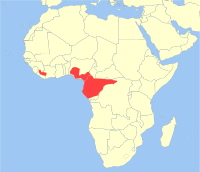Greater spot-nosed monkey
| Greater spot-nosed monkey[1] | |
|---|---|
| | |
| Scientific classification | |
| Kingdom: | Animalia |
| Phylum: | Chordata |
| Class: | Mammalia |
| Order: | Primates |
| Family: | Cercopithecidae |
| Genus: | Cercopithecus |
| Species: | C. nictitans |
| Binomial name | |
| Cercopithecus nictitans (Linnaeus, 1766) | |
 | |
| Geographic range | |
The greater spot-nosed monkey or putty-nosed monkey (Cercopithecus nictitans) is one of the smallest Old World monkeys. It is a guenon of the C. mitis group, native to West Africa and living to some extent in rain forests, but more often in the transition zone between rain forest and savannah. It is primarily arboreal and often associates with monkeys of other species.[3] Both their common names come from the monkeys' prominent white nose.
The greater spot-nosed monkey lives in groups consisting of one adult male, a number of adult females, and their dependent offspring.[4] Little recent research has been conducted into its behaviour, and most has concentrated on its auditory communication. Males use three call types which have been described as 'booms', 'pyows', and 'hacks'. These are used in a number of contexts including as alarm calls.
As in some other species of monkeys, the acoustical structure of greater spot-nosed monkey alarm calls it has been argued to vary according to the kind of predator spotted.[4] The monkey reportedly combines different sounds into a sequence, which has an entirely different meaning from the sounds out of which it is made.[5] For instance, the sound "pyow" alone means another animal, like a leopard, is lurking nearby, and "hack" means a flying animal, like an eagle, is flying nearby, but when the two are combined, as in the sequence "pyow pyow hack hack hack hack", they have an entirely different meaning: Let's get out of here and move to another place.
References
- ↑ Groves, C.P. (2005). Wilson, D.E.; Reeder, D.M., eds. Mammal Species of the World: A Taxonomic and Geographic Reference (3rd ed.). Baltimore: Johns Hopkins University Press. p. 157. OCLC 62265494. ISBN 0-801-88221-4.
- ↑ Oates, J. F. & Groves, C. P. (2008). "Cercopithecus nictitans". IUCN Red List of Threatened Species. Version 2008. International Union for Conservation of Nature. Retrieved 4 January 2009.
- ↑ Eckardt, W.; Zuberbühler, K. (2004). "Cooperation and competition in two forest monkeys". Behavioural Ecology. 15: 400–411. doi:10.1093/beheco/arh032.
- 1 2 Arnold, K. & Zuberbühler, K. (2006). "The alarm-calling system of adult male putty-nosed monkeys, Cercopithecus nictitans martini". Animal Behaviour. 72: 643–653. doi:10.1016/j.anbehav.2005.11.017.
- ↑ Arnold, K. & Zuberbühler, K (2008). "Meaningful call combinations in a non-human primate". Current Biology. 18 (5): R202–R203. doi:10.1016/j.cub.2008.01.040. PMID 18334192.
External links
| Wikispecies has information related to: Cercopithecus nictitans |
